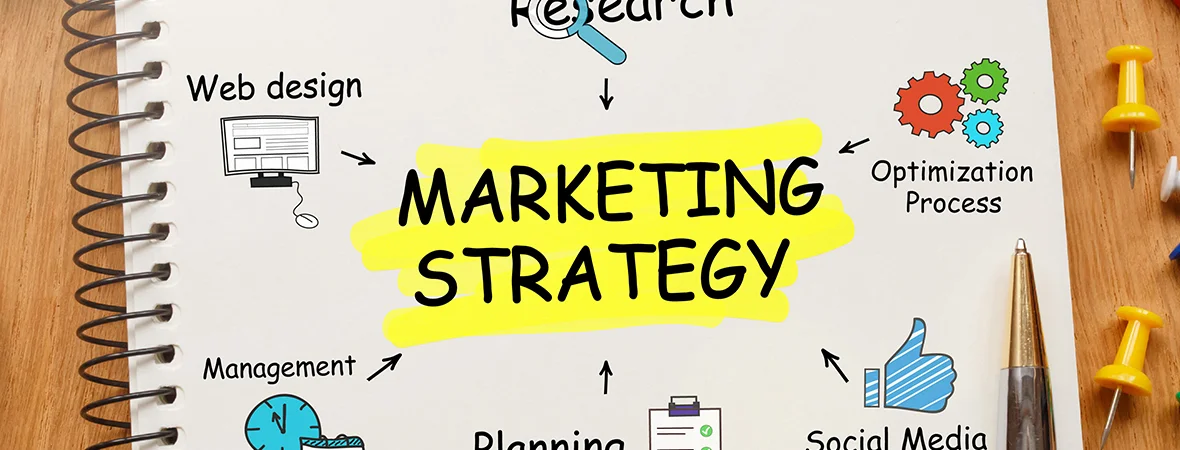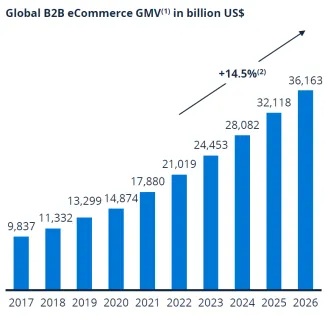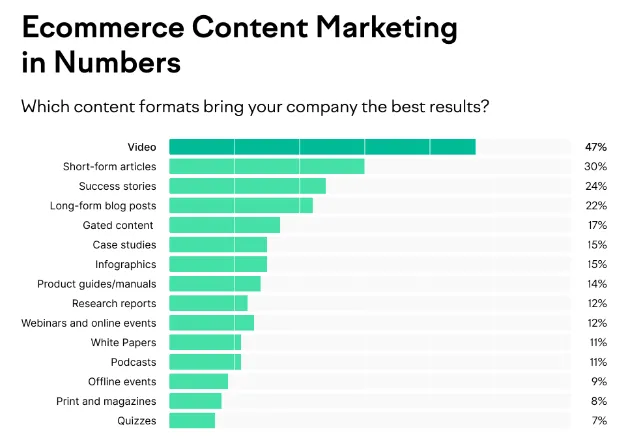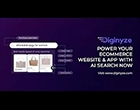
You're running an online store and have great products, but how do you get people to find you in the vast online sea of competitors? That's where growth marketing comes in. It's like a secret weapon for eCommerce businesses, helping you attract more customers, boost sales, and ultimately, build a thriving online empire.

Source: International Trade Administration
Growth marketing isn't just about throwing random tactics at the wall and hoping that it works. It's a strategic approach that uses data and experimentation to figure out what works best for your business. Think of it as constantly testing new recipes in your marketing kitchen until you discover the perfect ones that bring in hungry customers.
Let's deep dive into the top 9 strategies businesses can use to dominate the eCommerce realm:
1. SEO: Become the Search Engine Superstar
Most people find products online through search engines like Google. That is why SEO (Search Engine Optimization) is like the golden ticket for any eCommerce success. It involves optimizing your website's content and structure so it shows up high in search results when people type in keywords related to your products.
Here's how:
-
Keyword Research: The first step is figuring out what words and phrases people are actually searching for. For example, keywords as search terms like "women's running shoes" or "best gaming laptops." Use keyword research tools to find relevant keywords with good search volume (how many people are searching for them).
-
Appealing Content: Once you have your keywords, sprinkle them throughout your website content in a natural way. This includes product descriptions, blog posts, and even website page titles. But remember, don't just stuff keywords in there – create informative and engaging content that people actually want to read.
-
Link Building: Search engines also consider how many other websites link to yours. This tells them your site is valuable and trustworthy. Encourage other websites and bloggers to link to your content by creating high-quality, shareable content and reaching out to relevant websites.
By mastering the art and science of SEO eCommerce marketing for your online store, you'll attract a steady stream of potential customers who are already searching for products like yours.
Read also: Your Ultimate Guide to Building Market-Winning Product Listings
2. Content Marketing: Inform, Engage, and Convert
Content marketing is all about creating valuable content that attracts and engages your target audience. Think of it as building trust and becoming a trusted resource for your customers. This could include:
-
Blog Posts: Share informative and interesting blog posts related to your products or your industry.
-
Product Descriptions: Don't just list features – tell a story about your products and how they can benefit customers.
-
Videos: Create engaging product demos, explainer videos, or even behind-the-scenes content.
-
Guides and Tutorials: Offer helpful guides on how to use your products or solve problems related to your industry.
The key is to consistently create high-quality content that educates, entertains, and ultimately positions you as an expert in your field. When people see you as a valuable resource, they're more likely to trust you and buy from you.

Source: Semrush
3. Social Media Marketing: Where Your Audience Hangs Out
Social media platforms are buzzing with potential customers. By using these platforms strategically, you can connect with your audience, build brand awareness, and drive traffic to your online store. Here's how:
-
Choose the Right Platforms: Not all social media platforms are created equal. Focus on the ones where your target audience spends most of their time.
-
Post Engaging Content: Don't just bombard people with sales pitches. Share a mix of content like product updates, interesting industry news, behind-the-scenes glimpses, and even fun quizzes or polls.
-
Run Contests and Giveaways: Generate excitement and engagement by running contests and giveaways. This is a great way to get people talking about your brand and attract new followers.
-
Interact with Your Audience: Respond to comments and messages promptly. Show your audience you care about their feedback and questions.
Social media can be a powerful tool to build relationships with your customers and turn followers into loyal fans.
Read more at: Debunking the Secrets of Social Commerce with Diginyze
4. Email Marketing: A Direct Link to Your Audience
Email marketing is one of the most effective ways to connect with your customers. Here's what you can do:
-
Build Your Email List: Encourage website visitors to sign up for your email list by offering valuable incentives like discounts or exclusive content.
-
Segment Your List: Don't just send the same email to everyone. Group your email list based on interests or purchase history. This allows you to send targeted emails.
-
Craft Compelling Emails: Don't just send boring newsletters. Write engaging emails with clear subject lines that entice people to open them. Offer valuable content, exclusive promotions, or personalized product recommendations.
-
Track and Analyze Results: Keep an eye on how well your email campaigns are performing. See which emails have the highest open rates and click-through rates. Use this data to refine your email marketing strategy for even better results.
By building a strong email list and sending targeted, valuable emails, you can nurture leads, drive sales, and build long-term customer loyalty.

Source: Ecommerce Guide & Statista
5. Paid Advertising: Get Seen Quickly, Strategically
Paid advertising on platforms like Google Ads and social media advertising can be a great way to get your products in front of a wider audience quickly. Here are some things to keep in mind:
-
Target the Right People: Don't waste your money showing ads to people who aren't interested in what you're selling. Use detailed targeting options to reach your ideal customers.
-
Craft Compelling Ads: Make sure your ads stand out from the crowd. Use eye-catching visuals, clear messaging, and strong calls to action (CTAs) that tell people what you want them to do (visit your website, buy a product, etc.)
-
Track Your Results: Just like with email marketing, keep an eye on the performance of your paid ad campaigns. See which ads are generating the most clicks and conversions. Use this data to optimize your campaigns and get the most bang for your buck.
Paid advertising can be a powerful tool to accelerate your growth, but it's important to use it strategically.
6. Mobile Optimization: Make Sure Your Store Shines on Small Screens
With more and more people shopping online using their smartphones and tablets, it's crucial to ensure your eCommerce website is mobile-friendly. This means:
-
Responsive Design: Your website should automatically adjust to fit the size of the screen it's being viewed on.
-
Fast Loading Times: No one wants to wait for a slow website to load on their phone. Optimize your website images and code to ensure fast loading speeds for mobile users.
-
Easy Navigation: Make it easy for people to browse your products and complete purchases on their mobile devices. Use clear buttons, large fonts, and simple menus.
By prioritizing m-commerce, you'll ensure a smooth shopping experience for all your customers, no matter what device they use.
Also read: Transforming Mobile Shopping Experience with AI
7. Conversion Rate Optimization (CRO): Turn Visitors into Paying Customers
Not everyone who visits your website will automatically become a paying customer. Conversion Rate Optimization (CRO) is all about figuring out how to get more visitors to actually buy something onto website. Here's how:
-
A/B Testing: This involves testing different versions of your website elements (like product descriptions, call-to-action buttons, or checkout processes) to see which ones convert better.
-
Heatmaps and Analytics: Use heatmaps and website analytics tools to see how visitors interact with your website. This can help you identify areas where they might be getting confused or frustrated, allowing you to make improvements.
-
Optimize Your Checkout Process: Make the checkout process as smooth and easy as possible. Offer multiple payment options, streamline the steps involved, and ensure a secure checkout experience.
By constantly testing and refining your website based on data, you can significantly increase your conversion rate and get more sales from your existing website traffic.
8. Customer Relationship Management (CRM): Building Lasting Relationships
It's not just about acquiring new customers – it's also about retaining the ones you have. eCommerce CRM helps to nurture relationships with your existing customers and encourage repeat business. Here are some tips:
-
Personalization: Use customer data to personalize your marketing efforts. Send them targeted emails based on their purchase history or interests.
-
Loyalty Programs: Reward your loyal customers with exclusive discounts, early access to new products, or special benefits. This encourages them to keep coming back for more.
-
Provide Excellent Customer Service: Treat your customers with respect and respond to their inquiries promptly. A positive customer service experience can go a long way in building customer loyalty.
By focusing on building strong relationships with your customers, you can increase their lifetime value and ensure they become your biggest fans.
9. Data-Driven Decision Making: Let the Numbers Guide You
Growth marketing isn't about guesswork. It's about using data to make informed decisions. Here's how:
-
Track Key Metrics: Track website traffic, customer behavior, email open rates, social media engagement, and campaign performance.
-
Analyze the Data: Use advanced AI-powered eCommerce analytics to understand what's working and what's not. Identify trends and patterns in your data.
-
Make Data-Driven Decisions: Use the insights from your data to refine your marketing strategies and optimize your campaigns for better results.
Data empowers you to constantly improve your eCommerce business and make adjustments that drive real results.
Read also: Why Data-Driven eCommerce is the Key to Success
Takeaway
Growth marketing isn't just a collection of tactics; it's a comprehensive approach that fuels long-term eCommerce success. By relentlessly testing, analyzing data, and optimizing campaigns, you can nurture a thriving online business. Diginyze empowers you on this journey. It is an all-in-one AI-powered eCommerce platform that integrates seamlessly with your growth marketing strategies, providing powerful tools for SEO, content marketing, email marketing, and much more. With Diginyze, you can transform data insights into actionable strategies and watch your eCommerce store flourish.
Ready to get onboard the next-gen AI-powered eCommerce platform? Contact us today.
Recent Blogs
Explore latest insights and trends in technology and eCommerce.
Case Studies
Your Digital Transformation Starts Here!
Join thousands of businesses transforming with Diginyze. Sign up today and start now!


























